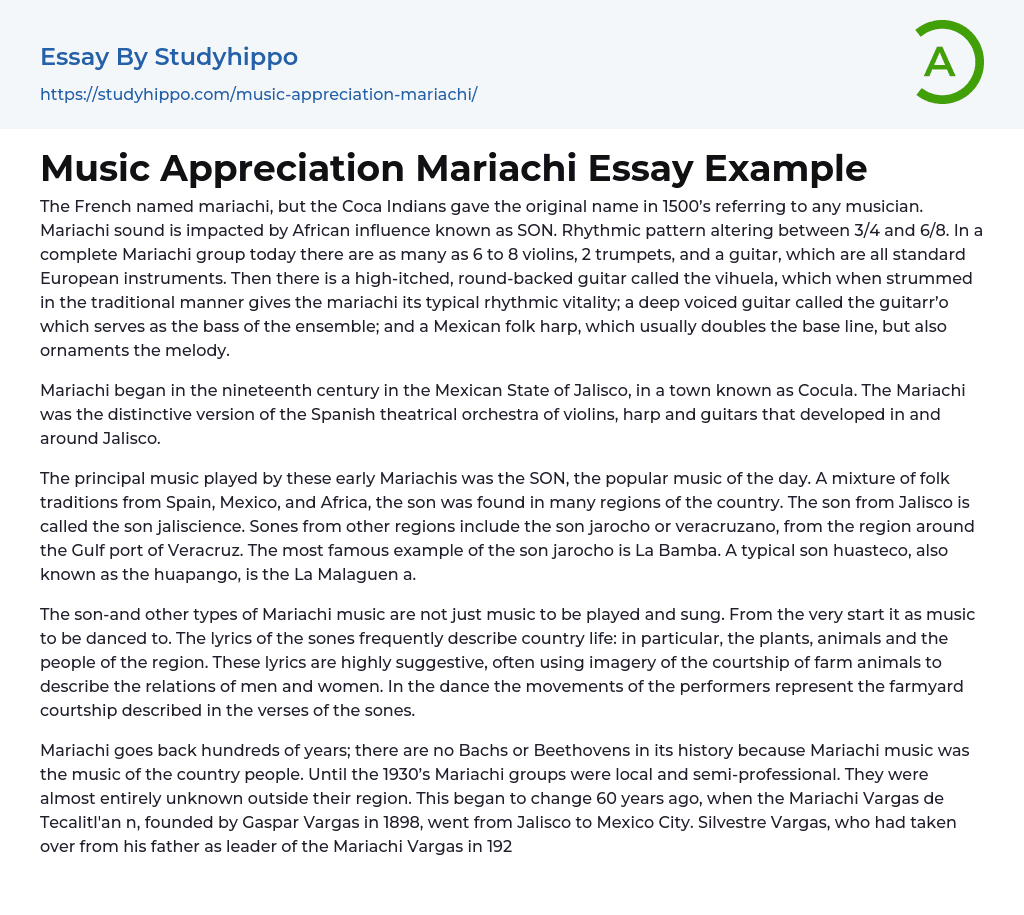The original name for mariachi was given by the Coca Indians in the 1500s, referring to any musician. The French later named it mariachi. The mariachi sound is influenced by African music known as SON, which has a rhythmic pattern alternating between 3/4 and 6/8 time signatures. A complete mariachi group today typically includes 6 to 8 violins, 2 trumpets, and a guitar, which are all standard European instruments. Additionally, there is a high-pitched, round-backed guitar called the vihuela that provides the typical rhythmic vitality when strummed traditionally. The ensemble also includes a deep-voiced guitar called guitarr'o that serves as the bass, and a Mexican folk harp that usually doubles the bass line and ornaments the melody. Mariachi originated in the nineteenth century in Cocula, a town in the Mexican state of Jalisco. It deve
...loped as a distinctive version of the Spanish theatrical orchestra consisting of violins, harp, and guitars that were popular in and around Jalisco.
The early Mariachis primarily played the SON, which was the popular music of that time. The SON was a blend of folk traditions from Spain, Mexico, and Africa and was prevalent in various parts of the country. Specifically, the son from Jalisco was known as the son jaliscience. Other regions had their own versions, such as the son jarocho or veracruzano, originating from the area near the Gulf port of Veracruz. One widely recognized example of the son jarocho is the famous song La Bamba.
The La Malaguena is a typical son huasteco, also called huapango. The son, along with other types of Mariachi music, is not limited to being played and sung. It has always been intended for dancing
as well. The sones often have lyrics that depict rural life, specifically the flora, fauna, and inhabitants of the area.
The lyrics in this text are suggestive and make use of imagery involving farm animals to describe the relationships between men and women. During the dance, the performers' movements depict the courtship of animals on the farm as described in the verses of the sones. Mariachi music has a long history, dating back several centuries. Unlike other genres like Bachs or Beethovens, Mariachi music was traditionally associated with the country people. Up until the 1930s, Mariachi groups were primarily local and composed of semi-professional musicians. They remained largely unknown outside of their respective regions. However, this began to change approximately 60 years ago when Mariachi Vargas de Tecalitl'an, founded by Gaspar Vargas in 1898, made their way from Jalisco to Mexico City.
Silvestre Vargas succeeded his father as leader of the Mariachi Vargas in 1928. He soon recruited Rubi n Fuentes, a skilled musician, as the musical director. Fuentes, who remains an integral part of the Mariachi Vargas even after more than fifty years, is a prominent figure in the evolution of the Mariachi. During the 1950s, Mariachi musicians had to acquire the ability to read music, which altered the manner in which Mariachi music was transmitted between different groups.
Gone was the musicians' complete reliance on their ears to learn new songs and techniques. By the 1950s, the Mariachi ensemble had evolved into a versatile orchestra, incorporating 2 trumpets, a classical guitar, and more violins. It retained its traditional foundation while assimilating new musical ideas and styles. Mariachis often play a role in celebrating important moments
in Mexican people's lives. They participate in courtship rituals through serenades and even contribute to the Mass, the most revered ceremony of the Roman Catholic Church. Mariachi music is taught in all levels of education, from grade school to university. USC alone has over 13 Mariachi clubs and groups, and the same can be said for other universities.
Mariachi is not only a form of entertainment at restaurants, but also at other venues like El Presidente's bar on Friday nights. Many dining establishments have followed their lead. Additionally, Mariachi groups perform in local parks and concerts across various states such as California to Texas.
- Band essays
- Baroque Music essays
- Blues essays
- Classical Concert essays
- Classical Music essays
- Concert essays
- Hip Hop essays
- Jazz essays
- Ludwig Van Beethoven essays
- Michael Jackson essays
- Mp3 essays
- Music Concert Report essays
- Music Reference essays
- Music video essays
- Musical Instruments essays
- Opera essays
- Piano essays
- Popular music essays
- Recording essays
- Rock And Roll essays
- Rock Music essays
- Singing essays
- Sonata essays
- Song essays
- Sonnet essays
- Tupac shakur essays
- Atom essays
- Big Bang Theory essays
- Density essays
- Electricity essays
- Energy essays
- Force essays
- Heat essays
- Light essays
- Motion essays
- Nuclear Power essays
- Physiology essays
- Sound essays
- Speed essays
- Temperature essays
- Thermodynamics essays




